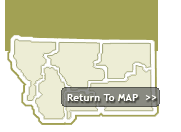

| Home | Communities | Accommodations | Places To Go | Things To Do | Site Map |
|
Glacier Country
Central Montana
Missouri River Country
Southwest Montana
Yellowstone Country
Southeast Montana
|

| ||||
 Lewis and Clark camped near Wolf Point on May 5, 1805. They noted in their journals that Clark killed a large grizzly bear on the banks of the Missouri. The bear was described a being 8 feet 7.5 inches long and weighed between 500 and 600 pounds.
Lewis and Clark camped near Wolf Point on May 5, 1805. They noted in their journals that Clark killed a large grizzly bear on the banks of the Missouri. The bear was described a being 8 feet 7.5 inches long and weighed between 500 and 600 pounds.One account of how Wolf Point took its name stems from an event which occurred in the trading days. During harsh winters trappers had success trapping and poisoning wolves, but the wolves froze before they could be skinned. The trappers piled the wolves along the banks of the river until spring, when they could be skinned. When the trappers returned for their skins the land had been taken over by Indians. The trappers were forced to leave and the spot became a landmark for steamboat crews, hence the name Wolf Point.


Assiniboine Village: The 40-acre site on the bank of the Missouri River explores the traditional Assiniboine culture. Visitors may experience the lifestyle of the Assiniboine including their customs, traditional foods, music and dances, games, and crafts; and may listen to tribal members tell about their history and religion.
Elevation: 1,997 feet
Wolf Point is located in northeastern area of Montana at the junction of US Highway 2 and 13.
Wolf Point AccommodationsBed & Breakfast (1)Hotel/Motel (3) Private Campground (1) Wolf Point RestaurantsCafe (1)Family Restaurant (2) Fast Food Restaurant (1) Sports Bar (1) | All Wolf Point BusinessesAirport (1)Banking Service (2) Car Rental (1) Chamber Of Commerce (1) Church (4) Department Store (1) Discount Store (1) Fairgrounds (1) Fishing Access Site (1) Museum (2) Rail Service (1) Semi-Private Golf Course (1) |
Cities near Wolf Point Montana
| Brockton Circle Flaxville Frazer | Glentana Lambert Nashua Opheim | Peerless Poplar Redstone Richey | Richland Scobey Vida Whitetail | Wolf Point |
A source for Montana Travel & Tourism Information
![]()